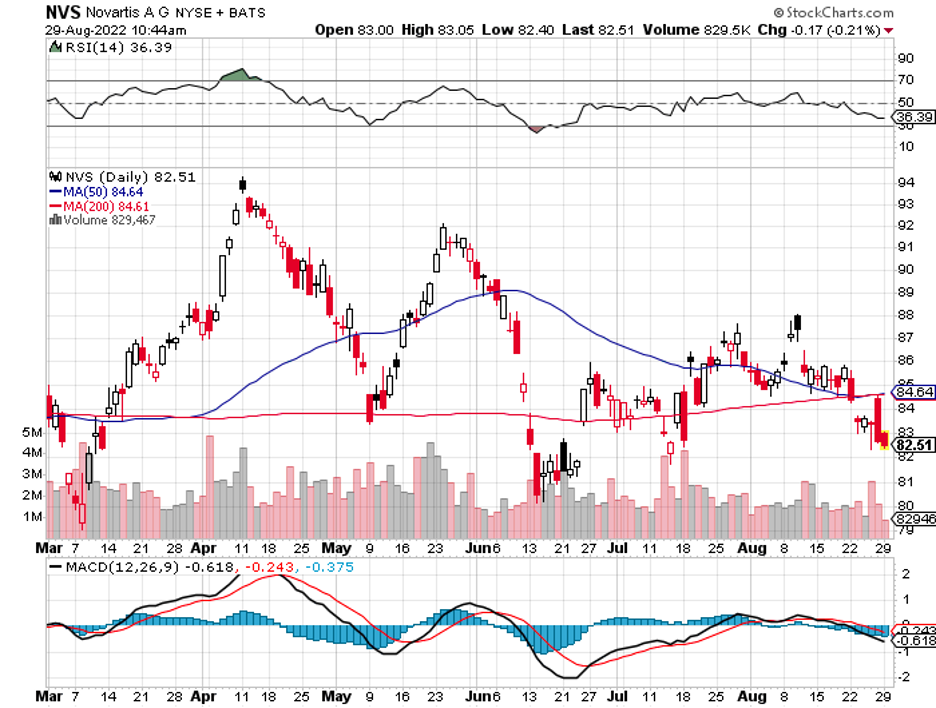With the US GDP sliding for another quarter, the economic projections are becoming increasingly hostile.
However, investors who have consistently been buying quality stocks could easily consider the gloomy economic conditions as a bump in the road.
One of the most resilient companies in the biotechnology and healthcare industry is Novartis (NVS).
The Swiss drugmaker, which has a massive market capitalization of $207 billion, is ranked as the sixth biggest pharma stock worldwide.
Over the past 12 months, Novartis has delivered better results than the overall pharmaceutical industry and the S&P 500. Its performance, albeit marginally better than the rest, proved its resilience amid such chaotic and complex situations.
Recently, Novartis announced that it would cut loose its Sandoz division, turning it into a standalone spinoff by the second half of 2022.
Basically, Novartis has two main segments: Innovative Medicine and Sandoz.
The company’s Innovative Medicine section comprises roughly 80% of its sales and centers on everything involving patented to prescription products.
Its Sandoz section, approximately 20% of the total sales, is further categorized into franchises: Biopharmaceuticals, Retail Generics, and Anti-Infectives.
The stay-behind business would be composed solely of the products in the Innovative Medicines segment, a combination of Novartis’ oncology and pharmaceuticals business divisions.
This makes Novartis the latest name to be added in the long line of Big Pharma players letting go of their generics division to strip away all but their core products in development.
The plan to spin off Sandoz, Novartis’ division concentrating on generics and biosimilars, has been in the works for quite some time now.
Prior to this announcement, there were even talks of a potential acquisition instead of creating a standalone company. However, no attractive enough offer was given, pushing Novartis to go ahead with its original plan.
Sloughing off the generics and biosimilars divisions could help solve some of the company’s issues.
The generic drug sector has been causing issues for drugmakers as of late, and sales of the Sandoz division have been notably stagnant compared to the steady growth of Novartis’ new drugs sector.
To put things in perspective, Sandoz’s net sales in 2021 was only $9.6 billion, while the company’s Innovative Medicine division raked in a whopping $42 billion.
Getting rid of Sandoz means Novartis could focus on more promising products in its portfolio and develop more blockbuster drugs in its pipeline.
For instance, the company can focus on expanding the treatments involving Cosentyx.
The top-selling drug in Novartis’ portfolio, making up 10% of total revenues, Cosentyx continues to rise rapidly, reporting double-digit growth.
This drug targets psoriatic arthritis and was valued at $7.15 billion in 2019. By 2027, this drug is expected to be worth $13.64 billion.
Most importantly, its patent will last longer as it will expire by 2028 in the US, 2029 in Japan, and 2030 in Europe.
Another blockbuster drug in Novartis portfolio is chronic heart failure treatment Entresto, which accounts for roughly 9% of the company’s total revenues. The growth of this product has been impressive thanks to the high demand in Europe, which means an increase in its sales is almost guaranteed.
Like Cosentyx, its patent will also last longer and is estimated to reach until 2036. This makes Entresto one of the most interesting—if not the most exciting—drug in Novartis’ pipeline.
Novartis is also becoming a significant player in the metastatic breast cancer market, estimated to grow from $15.52 billion in 2020 to $41.74 billion in 2030.
The company’s product in this segment, Kisqali, has been gradually taking up market share and is expected to gain more traction as it expands its indications.
In terms of growth, though, multiple sclerosis drug Kesimpta is the top performer in Novartis’ portfolio. In the second quarter of 2021, sales were at $22 million. In the same period in 2022, the number skyrocketed to $239 million.
Kesimpta is anticipated to become another blockbuster, especially with the projections in the multiple sclerosis market.
This segment is estimated to be worth $25.43 billion in 2022 and will grow to $33.17 billion by 2029. While the growth isn’t as massive as other segments, the exciting news is that Kesimpta has been outpacing the growth rate of the reference market thus far.
The move to eliminate Sandoz is in line with the ongoing aggressive slimming down of the company’s operations.
In 2014, Novartis sold its animal health segment to Eli Lilly (LLY). A few years after, it spun off its eye-care sector to become Alcon (ALC), then sold its consumer health segment to GlaxoSmithKline (GSK) for $13 billion.
Meanwhile, the decision to become a pure-play pharma has become a widespread trend among prominent names in the industry, with the likes of Pfizer (PFE), Johnson & Johnson (JNJ), and Bristol Myers Squibb (BMY) transforming into sleeker and slimmer businesses.
Ultimately, the goal is for these pharma giants to shed unwanted weight to compete in the faster-paced biotechnology world. The plan is to focus all their resources on advancing the science and developing the technology needed to come up with the next groundbreaking innovation.
With Novartis joining the bandwagon, we can expect its growth to accelerate over the long term as it focuses more on strengthening its already solid and impressive pipeline. I highly suggest that you buy the dip.

